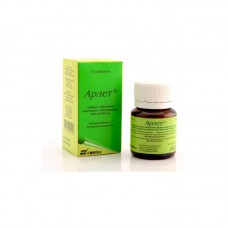Expiration date: 09/2026
Composition and form of issue:
Tablets, film-coated 1 tab.
amoxicillin (trihydrate) 250 mg
clavulanic acid (in the form of potassium salt) 125 mg
excipients: povidone (polyvinylpyrrolidone) talc starch 1500 calcium stearate silicon dioxide colloidal (Aerosil) MCC
shell: hypromellose (oksipropilmetiltselljuloza) propylene glycol titanium dioxide macrogol 4000 (polyethylene oxide 4000)
in a contour acheikova package 7 PC., in a package 2 package in the stack cartons 1 package or in the banks dark glasses 14 PCs the paper cartons 1 Bank.
Tablets, film-coated 1 tab.
amoxicillin (trihydrate) 500 mg
clavulanic acid (in the form of potassium salt) 125 mg
excipients: povidone (polyvinylpyrrolidone) talc starch 1500 calcium stearate silicon dioxide colloidal (Aerosil) MCC
shell: hypromellose (oksipropilmetiltselljuloza) propylene glycol titanium dioxide macrogol 4000 (polyethylene oxide 4000)
in a contour acheikova package 7 PC., in a package 2 package in the stack cartons 1 package or in the banks dark glasses 14 PCs the paper cartons 1 Bank.
Tablets, film-coated 1 tab.
amoxicillin (trihydrate) 875 mg
clavulanic acid (in the form of potassium salt) 125 mg
excipients: povidone (polyvinylpyrrolidone) talc starch 1500 calcium stearate silicon dioxide colloidal (Aerosil) MCC
shell: hypromellose (oksipropilmetiltselljuloza) propylene glycol titanium dioxide macrogol 4000 (polyethylene oxide 4000)
in a contour acheikova package 7 PC., in a package 2 package in the stack cartons 1 package or in the banks dark glasses 14 PCs the paper cartons 1 Bank.
Description of dosage form:
Tablets white or almost white, oblong.
Characteristic:
Broad-spectrum antibiotic.
Pharmacokinetics:
The main pharmacokinetic parameters amoxicillin and clavulanic acid are similar.
Suction
After taking the drug inside both components are well absorbed from the gastrointestinal tract, eating does not affect the degree of absorption. Cmax in blood plasma is reached after 1 h after administration of the drug and is (depending on the dose) for amoxicillin 3-12 µg/ ml, for clavulanic acid-about 2 µg / ml.
Distribution
Both components are characterized by a good volume of distribution in the body fluids and tissues (including the lungs, middle ear, pleural and peritoneal fluid, uterus, ovaries). Amoxicillin also penetrates into synovial fluid, liver, prostate gland, Palatine tonsils, muscle tissue, gall bladder, the secret of the sinuses, saliva, bronchial secret.
Amoxicillin and clavulanic acid do not penetrate the BBB in unheated meninges.
The active ingredients penetrate the placental barrier and are excreted in the trace concentrations with breast milk. The degree of binding to plasma proteins is low.
Metabolism
Amoxicillin is partially metabolised, clavulanic acid is, apparently, an intense metabolism.
Breeding
Amoxicillin is excreted by the kidneys almost unchanged by tubular secretion and glomerular filtration. Clavulanic acid is eliminated by glomerular filtration and partly in the form of metabolites. Small amounts can be excreted through the intestines and lungs.
T1 / 2 amoxicillin and clavulanic acid-1-1. 5 hours
Pharmacokinetics in special clinical cases
In severe renal insufficiency T1 / 2 increases to 7, 5 h for amoxicillin and to 4, 5 h — clavulanic acid. Both components are removed by hemodialysis and minor amounts by peritoneal dialysis.
Description of the pharmacological action:
Contains semi-synthetic penicillin-amoxicillin and an irreversible inhibitor of & beta-lactamase-clavulanic acid. Clavulanic acid provides a stable inactivated complex with these enzymes and provides resistance to amoxicillin &beta-lactamase produced by microorganisms.
Clavulanic acid, similar in structure to & beta-lactam antibiotics, has weak antibacterial activity of its own.
The drug has a wide range of antibacterial action.
Active against sensitive strains to amoxicillin, including strains, producing &beta-lactamase: aerobic gram-positive bacteria — Streptococcus pneumoniae, Streptococcus pyogenes, Streptococcus viridans, Streptococcus bovis, Staphylococcus aureus (except methicillin-resistant strains), Staphylococcus epidermidis (except methicillin-resistant strains), Staphylococcus saprophyticus, Listeria spp., Enterococcus spp. aerobic gram-negative bacteria-Bordetella pertussis, Brucella spp., Campylobacter jejuni, Escherichia coli, Gardnerella vaginalis, Haemophilus influenzae, Haemophilus ducreyi, Klebsiella spp., Moraxella catarrhalis, Neisseria gonorrhoeae, Neisseria meningitidis, Pasteurella multocida, Proteus spp., Salmonella spp., Shigella spp., Vibrio cholerae, Yersinia enterocolitica, Helicobacter pylori, Eikenella corrodens is a gram-positive anaerobic bacteria Peptococcus spp., Peptostreptococcus spp., Clostridium spp., Actinomyces israelii, Fusobacterium spp., Prevotella spp. anaerobic gram-negative bacteria-Bacteroides spp.
Indications:
Treatment of infectious and inflammatory diseases caused by microorganisms sensitive to the drug:
- infections of the upper respiratory tract and ENT-organs (including acute and chronic sinusitis, acute and chronic otitis media, retropharyngeal abscess, tonsillitis, pharyngitis)
- infections of the lower respiratory tract (including acute bronchitis bacterial superinfection, chronic bronchitis, pneumonia)
- urinary tract infection
- gynecological infections
- skin and soft tissue infections
- bone and connective tissue infections
- biliary tract infections (cholecystitis, cholangitis)
- odontogenic infections.
Contraindications:
- hypersensitivity to amoxicillin or clavulanic acid, antibiotics penicillin group, cephalosporins
- infectious mononucleosis (including the appearance of morbilliform rash)
- children under 3 years of age.
With caution:
- hepatic insufficiency of severe degree
- diseases of the gastrointestinal tract (including colitis associated with the use of antibiotics penicillin group, history)
- chronic renal failure.
Application for pregnancy and breastfeeding:
The drug is prescribed with caution during pregnancy and lactation (breastfeeding).
Arlet can be used during pregnancy if the expected benefit to the mother exceeds the potential risk to the fetus.
Amoxicillin and clavulanic acid in small quantities are excreted in breast milk, so if necessary, the appointment of the drug during lactation should decide on the termination of breastfeeding.
Side effect:
From the digestive system: loss of appetite, nausea, vomiting, diarrhea rarely — impaired liver function, increased Alt and AST activity in isolated cases — cholestatic jaundice, hepatitis, pseudomembranous colitis.
CNS: dizziness, headache, reversible hyperactivity and convulsions.
From the hematopoietic system: reversible increase in prothrombin time, leukopenia, reversible agranulocytosis and hemolytic anemia.
From the genitourinary system: interstitial nephritis, crystalluria.
Allergic reactions: itching, urticaria, erythematous rash rarely-multiform exudative erythema, angioedema, anaphylactic shock in rare cases — exfoliative dermatitis, Stevens-Johnson syndrome.
Other: development of superinfection (including candidiasis).
Drug interaction:
With simultaneous use of Arlet increases the toxicity of methotrexate.
With the simultaneous use of Arlet with allopurinol increases the risk of developing exanthema.
With simultaneous use of Arlet with antacids, glucosamine, laxatives, aminoglycosides absorption slows down, with ascorbic acid — increases.
While the use of Arleta with bactericidal antibiotics (including aminoglycosides, cephalosporins, cycloserine, vancomycin, rifampicin) appears synergies action with antibiotics with a bacteriostatic mechanism of action (including macrolides, chloramphenicol, lincosamides, tetracyclines) and sulfonamides — antagonism.
With simultaneous use of Arlet increases the effectiveness of indirect anticoagulants by inhibiting intestinal microflora, reducing the synthesis of vitamin K and reducing the prothrombin index. At appointment of this combination it is necessary to carry out dynamic control of blood tests.
With simultaneous use of Arlet reduces the effectiveness of oral contraceptives.
With the simultaneous appointment of Arlet with drugs, during the metabolism of which paraaminobenzoic acid is formed, ethinyl estradiol increases the risk of breakthrough bleeding.
Diuretics, allopurinol, phenylbutazone, NSAIDs and other drugs that block tubular secretion, increase the concentration of amoxicillin (clavulanic acid is excreted mainly by glomerular filtration).
Method of application and doses:
Inside. Adults and children over 12 years old (or body weight >40 kg) when light or moderate course of infection, 1 table. 250/125 mg every 8 h or 1 table. 500/125 mg every 12 h, in the case of severe infection and respiratory infections-1 table. 500/125 mg every 8 h or 1 table. 875/125 mg every 12 hours
Children under 12 years weighing <40 kg the dose is selected individually based on the recommended dosing regimen (for amoxicillin) — 45 mg/kg/day in 2 admission or 40 mg/kg/day in 3 admission. The optimal dosage form for children from 6 to 12 years are 500/125 mg tablets when prescribed 2 times a day.
The maximum daily dose of clavulanic acid (in the form of potassium salt) for adults — 600 mg, for children — 10 mg/kg body weight. The maximum daily dose of amoxicillin for adults-6 g, for children — 45 mg / kg body weight.
The course of treatment — 5-14 days. The duration of treatment is determined by the attending physician. Treatment should not last more than 14 days without re-medical examination.
In odontogenic infections-1 table. 250/125 mg every 8 h or 1 table. 500/125 mg every 12 h for 5 days.
In case of moderate renal insufficiency (creatinine Cl 10-30 ml/min) - 1 table. 500/125 mg every 12 h for adults and 15/3, 75 mg/kg body weight twice a day for children under 12 years.
In severe renal failure (Cl creatinine <10 ml / min) - 1 table. 500/125 mg every 24 hours for adults, children under 12 years — 15/3, 75 mg/kg body weight once a day.
When anurii the interval between doses doses should be increased to 48 hours or more.
Adults who are on hemodialysis, the drug should be prescribed at a dose of 1 table. 500/125 mg or 2 tables. 250/125 mg every 24 hours to compensate for the decrease in the concentration of amoxicillin and clavulanic acid in serum during dialysis, you should additionally take 1 dose of the drug during a dialysis session and another dose at the end of the session.
Children who are on hemodialysis, the drug should be prescribed at a dose at the rate of 15/3, 75 mg / kg body weight 1 time per day. To compensate for the decrease in the concentration of amoxicillin and clavulanic acid in the blood during dialysis, you should additionally take 1 dose of the drug before the start of the dialysis session and another dose after the dialysis session.
Overdose:
Symptoms: abdominal pain, diarrhea, vomiting may also anxiety, insomnia, dizziness in some cases — seizures.
Treatment: in the case of a recent drug intake (<4 h), it is necessary to wash the stomach and appoint activated charcoal to reduce the absorption of the drug, the patient should be under medical supervision. If necessary, symptomatic therapy should be carried out. Effective hemodialysis.
Special instruction:
With caution, the drug is used in patients with impaired liver function, during treatment, regularly monitor liver function.
In the course of treatment should monitor the functions of hematopoietic, liver and kidneys.
In patients with severely impaired renal function requires adequate correction mode or increase the interval between doses of the drug.
In order to reduce the risk of adverse reactions from the gastrointestinal tract should take the drug during meals.
Since the tablets of the combined drug 250 mg / 125 mg and 500 mg / 125 mg contain the same amount of clavulanic acid (125 mg), table 2. 250 mg / 125 mg is not equivalent to 1 table. 500 mg / 125 mg.
The high concentration of amoxicillin give a false positive reaction in the determination of glucose in urine when using reagent Benedict or mortar of Felling (recommend the use of enzymatic reaction with glucosidase).
Influence on the ability to drive vehicles and management mechanisms
The drug in recommended doses does not affect the ability to drive vehicles and management of complex mechanisms.


